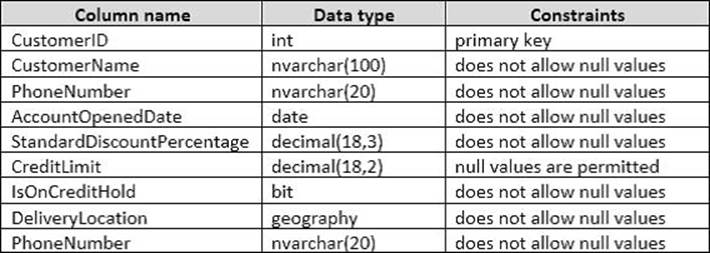HOTSPOT
Note: This question is part of a series of questions that use the same scenario. For your convenience, the scenario is repeated in each question. Each question presents a different goal and answer choices, but the text of the scenario is exactly the same in each question in this series.
You are developing a database to track customer orders. The database contains the following tables: Sales.Customers, Sales.Orders, and Sales.OrderLines.
The following table describes the columns in Sales.Customers.

The following table describes the columns in Sales.Orders.
The following table describes the columns in Sales.OrderLines.
You need to create a database object that calculates the total price of an order including the sales tax.
The database object must meet the following requirements:
– Reduce the compilation cost of Transact-SQL code by caching the plans and reusing them for repeated execution.
– Return a value.
– Be callable from a SELECT statement.
How should you complete the Transact-SQL statements? To answer, select the appropriate Transact-SQL segments in the answer area.
Answer:
Explanation:
Box 1: FUNCTION
To be able to return a value we should use a scalar function.
CREATE FUNCTION creates a user-defined function in SQL Server and Azure SQL Database. The return value can either be a scalar (single) value or a table.
Box 2: RETURNS decimal(18,2)
Use the same data format as used in the UnitPrice column.
Box 3: BEGIN
Transact-SQL Scalar Function Syntax include the BEGIN ..END construct.
CREATE [ OR ALTER ] FUNCTION [ schema_name. ] function_name
( [ { @parameter_name [ AS ][ type_schema_name. ] parameter_data_type
[ = default ] [ READONLY ] }
[ ,…n ]
]
)
RETURNSreturn_data_type
[ WITH <function_option> [ ,…n ] ]
[ AS ]
BEGIN
function_body
RETURN scalar_expression
END
[ ; ]
Box 4: @OrderPrice * @CalculatedTaxRate
Calculate the price including tax.
Box 5: END
Transact-SQL Scalar Function Syntax include theBEGIN ..END construct.
References: https://msdn.microsoft.com/en-us/library/ms186755.aspx
Latest 70-761 Dumps Valid Version with 212 Q&As
Latest And Valid Q&A | Instant Download | Once Fail, Full Refund